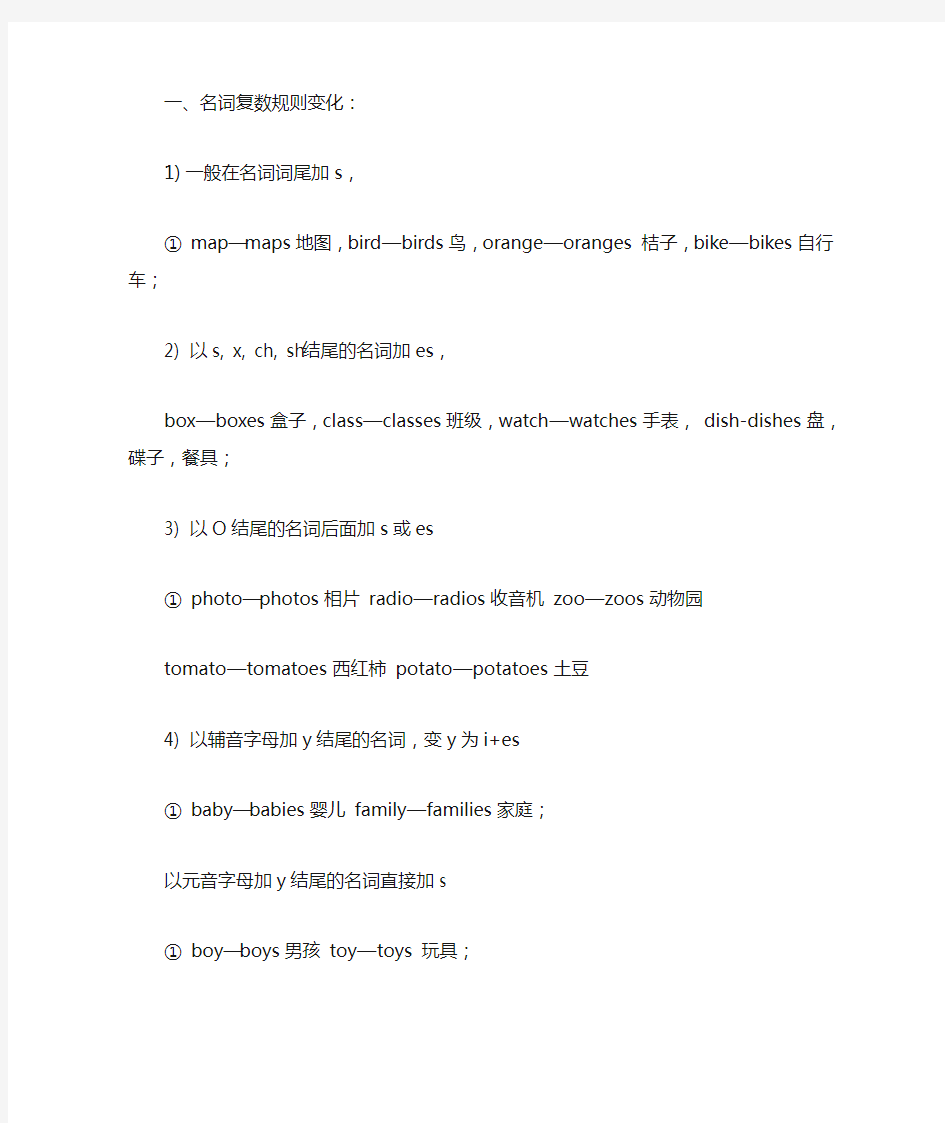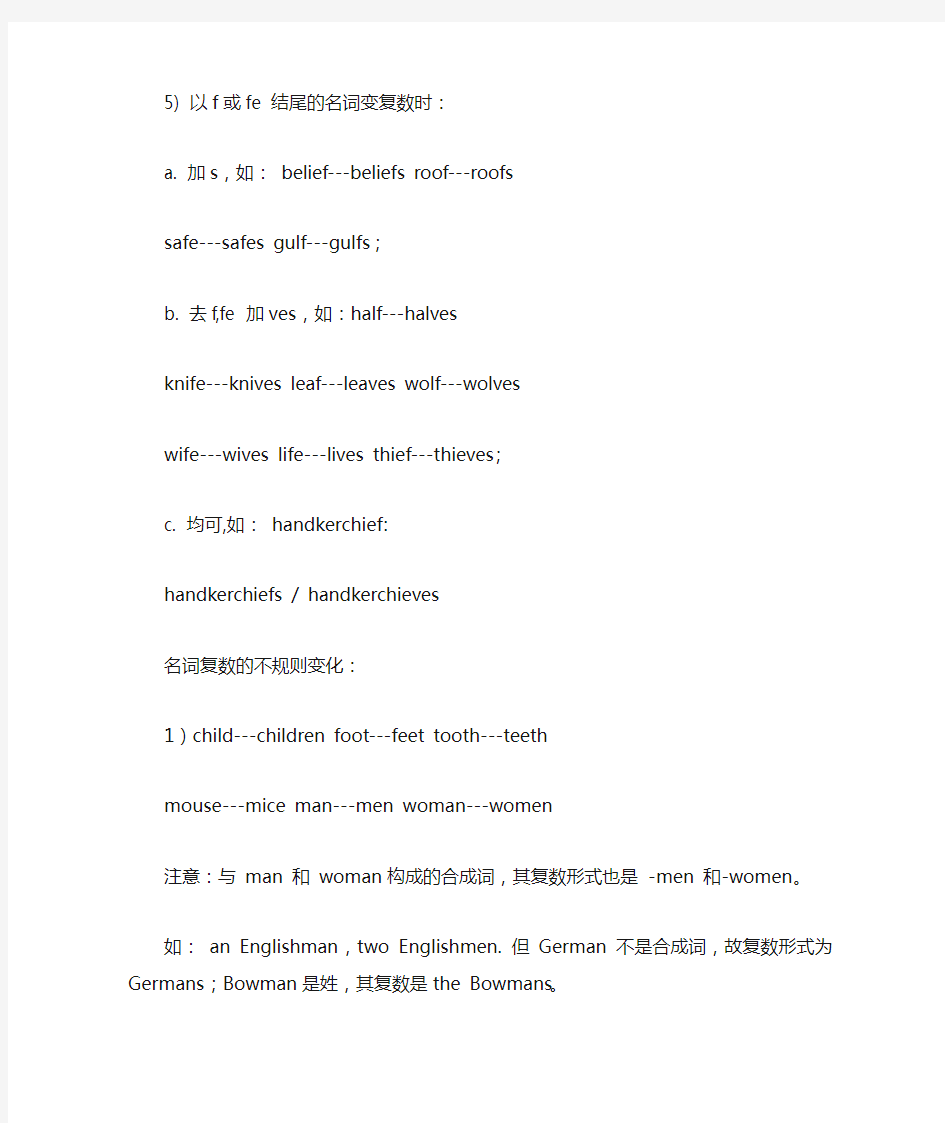pep小学英语语法总结


一、名词复数规则变化:
1)一般在名词词尾加s,
① map—maps地图,bird—birds鸟,orange—oranges 桔子,bike—bikes 自行车;
2) 以s, x, ch, sh结尾的名词加es,
box—boxes盒子,class—classes班级,watch—watches手表,
dish-dishes盘,碟子,餐具;
3) 以O结尾的名词后面加s或es
① photo—photos相片radio—radios收音机zoo—zoos动物园tomato—tomatoes西红柿potato—potatoes土豆
4) 以辅音字母加y结尾的名词,变y为i+es
① baby—babies婴儿family—families家庭;
以元音字母加y结尾的名词直接加s
① boy—boys男孩toy—toys 玩具;
5) 以f或fe 结尾的名词变复数时:
a. 加s,如:belief---beliefs roof---roofs
safe---safes gulf---gulfs;
b. 去f,fe 加ves,如:half---halves
knife---knives leaf---leaves wolf---wolves
wife---wives life---lives thief---thieves;
c. 均可,如:handkerchief:
handkerchiefs / handkerchieves
名词复数的不规则变化:
1)child---children foot---feet tooth---teeth
mouse---mice man---men woman---women
注意:与man 和woman构成的合成词,其复数形式也是-men 和-women。
如:an Englishman,two Englishmen. 但German不是合成词,故复数形式为Germans;Bowman是姓,其复数是the Bowmans。
2)单复同形如:
deer,sheep,fish,Chinese,Japanese
li,jin,yuan,two li,three mu,four jin
但除人民币元、角、分外,美元、英镑、法郎等都有复数形式。如: -
a dollar, two dollars; a meter, two meters
3)集体名词,以单数形式出现,但实为复数。
如:people police cattle 等本身就是复数,不能说 a people,a police,a cattle,但可以说
a person,a policeman,a head of cattle,the English,the British,the French,the Chinese,the Japanese,the Swiss 等名词,表示国民总称时,作复数用。
如:The Chinese are industries and brave. 中国人民是勤劳勇敢的。4)以s结尾,仍为单数的名词,如:
A). maths,politics,physics等学科名词,为不可数名词,是单数。
B). news 是不可数名词。
C). the United States,the United Nations 应视为单数。
The United Nations was organized in 1945. 联合国是1945年组建起来的。
d. 以复数形式出现的书名,剧名,报纸,杂志名,也可视为单数。-"The Arabian Nights" is a very interesting story-book.
<<一千零一夜>>是一本非常有趣的故事书。
5) 表示由两部分构成的东西,如:glasses (眼镜) trousers, clothes
若表达具体数目,要借助数量词pair(对,双); suit(套); a pair of glasses; two pairs of trousers
6)另外还有一些名词,其复数形式有时可表示特别意思,如:goods 货物,waters水域,fishes(各种)鱼
动词第三人称单数和名词变化相同。但是以“o”结尾的一半加“es”
规则动词的过去式词尾变化有几种:
1.一般情况下加ed,如watched, planted, watered, pulled, climbed, picked。
2.以不发音字母e结尾的加d,如liked, moved, tasted。
3.以辅音字母加y结尾的变y为i再加ed,如study——studied。(辅音字母指:除了a、e、i、o、u,5个元音字母以外的21的字母) 4.以1个元音字母加1个辅音字母结尾的重读闭音节,双写最后一个辅音字母再加ed,如stop——stopped。二、一般现在时
一般现在时基本用法介绍
【No. 1】一般现在时的功能
1.表示事物或人物的特征、状态。如:The sky is blue.天空是蓝色的。
2.表示经常性或习惯性的动作。如:I get up at six every day.我每天六点起床。
3.表示客观现实。如:The earth goes around the sun.地球绕着太阳转。
一般现在时的构成
1. be动词:主语+be(am,is,are)+其它。如:I am a boy.我是一个男孩。
2.行为动词:主语+行为动词(+其它)。如:
We study English.我们学习英语。
当主语为第三人称单数(he, she,it)时,要在动词后加"-s"或"-es"。如:Mary likes Chinese.玛丽喜欢汉语。
一般现在时的变化
1. be动词的变化。
否定句:主语+ be + not +其它。
如:He is not a worker.他不是工人。
一般疑问句:Be +主语+其它。
如:-Are you a student?
-Yes. I am. / No, I'm not.
特殊疑问句:疑问词+一般疑问句。如:Where is my bike?
2.行为动词的变化。
否定句:主语+ don't( doesn't ) +动词原形(+其它)。如:
I don't like bread.
当主语为第三人称单数时,要用doesn't构成否定句。如:
He doesn't often play.
一般疑问句:Do( Does ) +主语+动词原形+其它。如:
- Do you often play football?
- Yes, I do. / No, I don't.
当主语为第三人称单数时,要用does构成一般疑问句。如:
- Does she go to work by bike?
- Yes, she does. / No, she doesn't.
特殊疑问句:疑问词+一般疑问句。如:How does your father go to work?
动词+s的变化规则
1.一般情况下,直接加-s,如:cook-cooks, milk-milks
2.以s. x. sh. ch. o结尾,加-es,如:guess-guesses, wash-washes, watch-watches, go-goes
3.以“辅音字母+y”结尾,变y为i, 再加-es,如:study-studies
三、现在进行时
1.现在进行时表示现在正在进行或发生的动作,也可表示当前一段时间内的活动或现阶段正在进行的动作。
2.现在进行时的肯定句基本结构为be+动词ing.
3.现在进行时的否定句在be后加not。
4.现在进行时的一般疑问句把be动词调到句首。
5.现在进行时的特殊疑问的基本结构为:
疑问词不达意+ be + 主语+ 动词ing?
但疑问词当主语时其结构为:
疑问词不达意+ be + 动词ing?
动词加ing的变化规则
1.一般情况下,直接加ing,如:cook-cooking
2.以不发音的e结尾,去e加ing,如:make-making, taste-tasting 3.如果末尾是一个元音字母和一个辅音字母,双写末尾的辅音字母,再加ing,如:run-running, stop-stopping
四、将来时理论及练习
一、概念:表示将要发生的动作或存在的状态及打算、计划或准备做某事。句中一般有以下时间状语:tomorrow, next day(week, month, year…),soon, the day after tomorrow(后天)等。
二、基本结构:①be going to + do;
②will+ do.
三、否定句:在be动词(am, is, are)l后加not或情态动词will后加not成won’t。
例如:I’m going to have a picnic this afternoon.→ I’m not going to have a picnic this afternoon.
四、一般疑问句:be或will提到句首,some改为any, and改为or,第一二人称互换。
例如:We are going to go on an outing this weekend. → Are you going to
go on an outing this weekend?
五、对划线部分提问。一般情况,一般将来时的对划线部分有三种情况。
1. 问人。Who 例如:I’m going to New York soon. →Who’s going to New York soon.
2. 问干什么。What … do.例如:My father is going to watch a race with me this
afternoon. →What is your father going to do with you this afternoon.
3. 问什么时候。When.例如:She’s going to go to bed at nine. →When is she going to bed?
六、同义句:be going to = will
I am going to go swimming tomorrow(明天). = I will go swimming tomorrow.
五、一般过去时
1.一般过去时表示过去某个时间发生的动作或存在的状态,常和表示过去的时间状语连用。一般过去时也表示过去经常或反复发生的动作感谢。
2.Be动词在一般过去时中的变化:
⑴am 和is在一般过去时中变为was。(was not=wasn’t)
⑵are在一般过去时中变为were。(were not=weren’t)
⑶带有was或were的句子,其否定、疑问的变化和is, am, are一样,即否定句在was或were后加not,一般疑问句把was或were调到句首。
3.句中没有be动词的一般过去时的句子
否定句:didn’t +动词原形,如:Jim didn’t go home yesterday.
一般疑问句:在句首加did,句子中的动词过去式变回原形。
如:Did Jim go home yesterday?
特殊疑问句:⑴疑问词+did+主语+动词原形?
如:What did Jim do yesterday?
⑵疑问词当主语时:疑问词+动词过去式?
如:Who went to home yesterday?
动词过去式变化规则:
1.一般在动词末尾加-ed,如:pull-pulled, cook-cooked
2.结尾是e加d,如:taste-tasted
3.末尾只有一个元音字母和一个辅音字母的重读闭音节,应双写末尾的辅音字母,再加-ed,如:stop-stopped
4.以“辅音字母+y”结尾的,变y为i,再加-ed,如:st六、形容词和副词的比较级复习及练习
一、形容词的比较级
1、形容词比较级在句子中的运用:两个事物或人的比较用比较级,比较级后面一般带有单词than。比较级前面可以用more, a little 来修饰表示程度。than后的人称代词用主格(口语中可用宾格)。
2.形容词加er的规则:
⑴一般在词尾加er ;
⑵以字母e 结尾,加r ;
⑶以一个元音字母和一个辅音字母结尾,应双写末尾的辅音字母,再
加er ;
⑷以“辅音字母+y”结尾,先把y变i,再加er 。
3.不规则形容词比较级:
good-better, beautiful-more beautiful
二、副词的比较级
1.形容词与副词的区别(有be用形,有形用be;有动用副,有副用动)
⑴在句子中形容词一般处于名词之前或be动词之后
⑵副词在句子中最常见的是处于实义动词之后
2.副词比较级的变化规则基本与形容词比较级相同(不规则变化:well-better, far-farther)
sudy-studied
七、There be 句型与have, has的区别
1、There be 句型表示:在某地有某物(或人)
2、在there be 句型中,主语是单数,be 动词用is ; 主语是复数,be 动词用are ; 如有几件物品,be 动词根据最靠近be 动词的那个名词决定。
3、there be 句型的否定句在be 动词后加not , 一般疑问句把be 动词调到句首。
4、there be句型与have(has) 的区别:there be 表示在某地有某物(或人);have(has) 表示某人拥有某物。
5、some 和any 在there be 句型中的运用:some 用于肯定句,any 用于否定句或疑问句。
6、and 和or 在there be句型中的运用:and 用于肯定句,or 用于否定句或疑问句。
7、针对数量提问的特殊疑问句的基本结构是:
How many + 名词复数+ are there + 介词短语?
How much + 不可数名词+ is there + 介词短语?
8、针对主语提问的特殊疑问句的基本结构是:
What’s + 介词短语?
八、人称代词和物主代词
1、人称代词主格和宾格的区别:主格通常位于句中第一个动词之前(有时候位于than 之后),宾格一般位于动词或介词之后。
2、物主代词形容词性与名词性的区别:形容词性用时后面一般要带上名词,名词性则单独使用,后面不带名词。
人称代词物主代词
主格宾格形容词性名词性
我I me 我的my mine 你,你们you you 你的,你们的your yours
他he him 他的his his
她she her 她的her hers
它it it 它的its its
我们we us 我们的our ours 他(她,它)们they them 他(她,它)们的their theirs 不规则动词变化表
词义现在(原形)过去-ing形
是am (be) was being
是are (be) were being
是be was, were being
成为become became becoming
开始begin began beginning
弯曲bend bent bending
吹blow blew blowing
买buy bought buying
能can could --------
捕捉catch caught catching
选择choose chose choosing
来come came coming
切cut cut cutting
做do, does did doing
画draw drew drawing
饮drink drank drinking
吃eat ate eating
感觉feel felt feeling
发现find found finding
飞fly flew flying
忘记forget forgot forgetting
得到get got getting
给give gave giving
去go went going
成长grow grew growing
有have, has had having
听hear heard hearing
受伤hurt hurt hurting
保持keep kept keeping
知道know knew knowing
学习learn learned, learnt learning
让let let letting
躺lie lay lying
制造make made making
可以may might -----
意味mean meant meaning
会见meet met meeting
必须must must -----
放置put put putting 读read read reading 骑ride rode riding 响、鸣ring rang ringing
跑run ran running 说say said saying
看见see saw seeing
将shall should -----
唱歌sing sang singing 坐下sit sat sitting
睡觉sleep slept sleeping 说speak spoke speaking 度过spend spent spending
基数词序数词
0 zero
1 one first/1st 第一
2 two second/2nd 第二
3 three third/3rd 第三
4 four fourth/4th 第四
5 five fifth/5th 第五
6 six sixth/6th 第六
7 seven seventh/7th 第七
8 eight eighth/8th 第八
9 nine ninth/9th 第九
10 ten tenth/10th 第十
11 eleven eleventh/11th 第十一
12 twelve twelfth/12th 第十二
13 thirteen thirteenth/13th 第十三
14 fourteen fourteenth/14th 第十四
15 fifteen fifteenth/15th 第十五
16 sixteen sixteenth/16th 第十六
17 seventeen seventeenth/17th 第十七
18 eighteen eighteenth/18th 第十八
19 nineteen nineteenth/19th 第十九
20 twenty twentieth/20th 第二十
21 Twenty-one twenty-first/21st 第二十一
22 Twenty-two twenty-second/22nd 第二十二
23 Twenty-three twenty-third/23rd 第二十三30 thirty thirtieth/30th 第三十
40 forty fortieth/40th 第四十
50 fifty fiftieth/50th 第五十
60 sixty sixtieth/60th 第六十
70 seventy seventieth/70th 第七十
80 eighty eightieth/80th 第八十90 ninety ninetieth/90th 第九十100 hundred hundredth/100th 第一百
